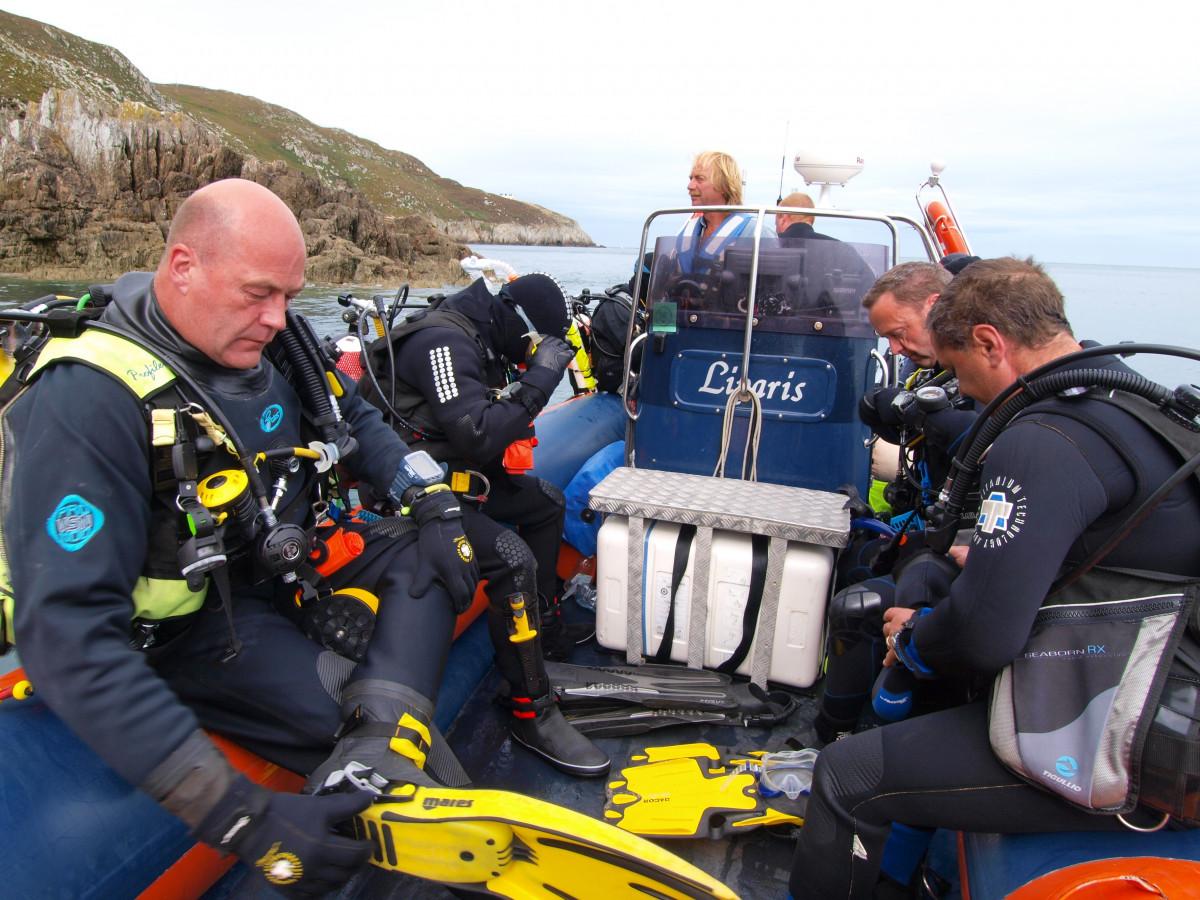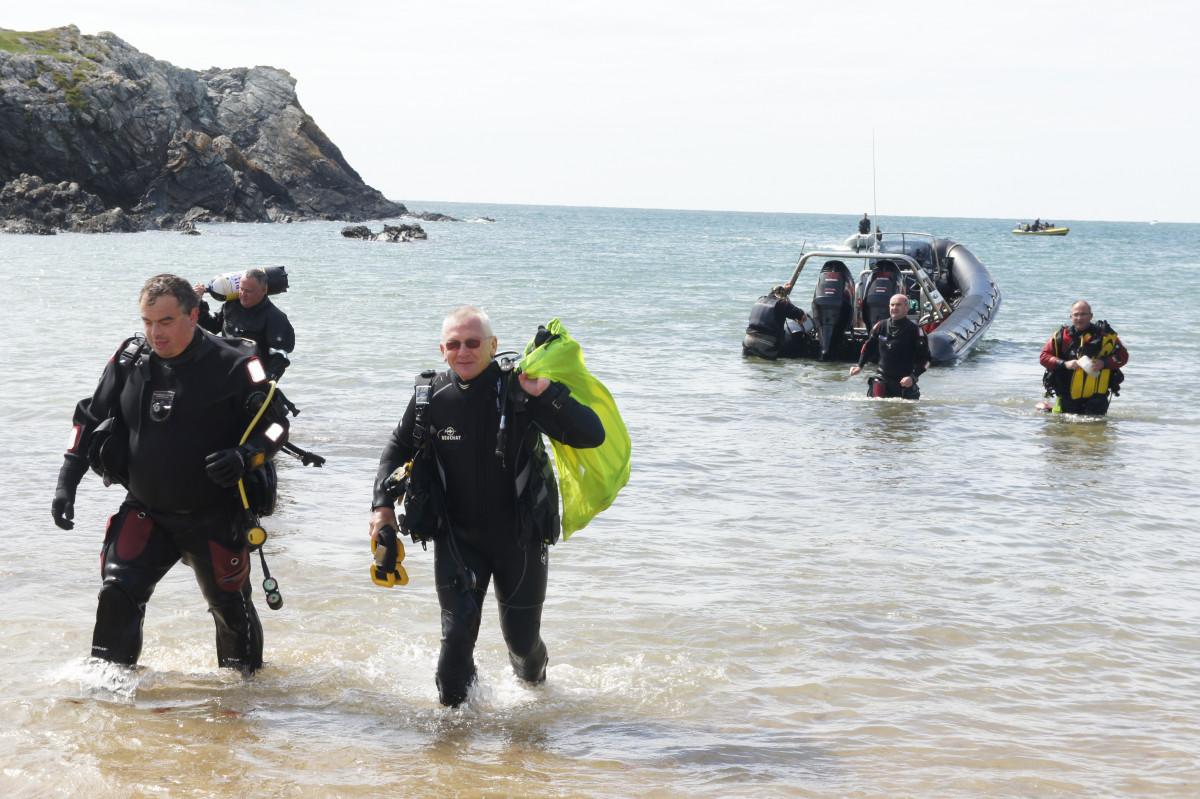RIB (rigid hull inflatable) diving is a staple of the diving scene, and our panel of experts offer up some handy hints and advice for diving from a RIB
RIBs – also known as RHIBs (rigid hull inflatable boats) – are often called the Land Rover Defender of the sea, as they are tough, durable, designed to cope with less-than-ideal conditions and, shall we say, fairly basic when it comes to creature comforts.
There is a breed of ‘leisure RIBs’ available now, as more and more dayboaters came to understand the benefits of a RIB on the open sea over a more-traditional speedboat, and these have bench seats and other useful additions. It is possible to dive from these, but most dive RIBs will be more spartan, with maybe the odd jockey seat and usually a stainless-steel tank rack to securely fasten the BCDs/cylinders in place.

Being out on the water in a RIB is exhilarating, and speeding to a dive site in one will be something familiar with many British divers, but if you have never had the opportunity yet, never fear, just soak up the advice that follows and you will be fine.
Adrian Collier, BSAC National Instructor, said: “Gone are the days when we tested how much fuel we had on our RHIB by a bamboo cane while we were 14 miles offshore getting ready to head back to harbour after an amazing dive. The old Johnson two-stroke engines that ate fuel and smoked the divers making them sick are distant memories of how it used to be out on the water.
“So what has changed? Technology has moved on, we now have modern two-stroke engines that are computer controlled with bluetooth technology to operate them. The first engine service comes after three years of usage and you get a ten-year warranty – how amazing is that! We also now have 3D sidescan sonar and chartplotters that are very much affordable for local diving clubs. All these things make diving safer.
“Incidents of broken-down engines are getting less and less due to the advent of new technology. Divers are being trained better with more going for qualification such as the BSAC Diver Coxswain Award, which is a recognised International Certificate of Competence. We now have strict guidelines we have to adhere to which came into force on 1 July 2002 SOLAS V Regulations. If we have not applied the basic outlines when we go to sea and there is a boating accident, you could be prosecuted. So, it is in our best interest to prepare and plan going to sea well before.
“BSAC has worked with other dive agencies to produce guidelines for the ‘Safe Operation of Member Club Dive Boats’. You can download a copy of these guidelines at www.bsac.com/boatsafety.”

Gary Asson, National Diving Officer of the Sub-Aqua Association, commented: “I have done some fantastic diving from RIBs. They were a great improvement on the inflatable, in terms of comfort, carrying capacity, equipment, potential distance. and safety. Their only real downside was that you could not just carry them across the beach to launch.
“Remember, the Coxswain is in overall charge of anything that happens on the RIB. The Cox will tell you where to store your scuba set, weightbelt, and even where to sit. This sound very dictatorial. However, the shape and size of the RIB makes its trim very important. The Cox will understand how weight distribution effects the vessel, and sort things out accordingly.
“When diving from a RIB, you are not really a passenger, you are part of the crew. Keep things tidy, be prepared to assist with kitting others up and helping divers back into the boat. Listen to the brief that will be given before the vessel moves off. Make a note of any safety feature that are pointed out, especially the location and use of the boat’s radio, flares, and spare kill switch clip. Just remember it may be the Coxswain that needs help.
“You should arrive at the RIB with your kit ready to go. Scuba set ready (Bottle, regs and BCD put together), dry/wetsuit donned. All the rest of your kit should be kept together in a suitable flexible bag. The goody (string) bag is ideal for this.
“Entry and exit should be explained and preferably practiced before the day. Rolling backwards off the RIB while holding your mask and ancillaries is quite easy. Once mastered, passing the weightbelt/ pouches and scuba set, while maintaining contact with the vessel, is easy, but requires some thinking about.

The actual method of getting back onto the RIB is a combination of pulling, finning and assistance. It is great watching a group of divers who know what they are doing getting everyone back onto the boat. A word of warning though, when you first start helping. It was quite funny watching two of the larger rugby-types getting a bit carried away, pulling my mother out of the water on one side of the RIB and depositing her in the water of the other!
“There very few tablets of stone when it comes to diving. However, please please, please. If the Coxswain refuses to use the kill cord, refuse to get on the RIB.”
Mark Powell, TDI/SDI’s Business Development Manager, said: “Diving from a RIB is one of those skills that many divers have never experienced. With more and more divers using hardboats and the switch from club-based diving to commercial operations, it is becoming less and less common. Many technical divers will turn up their noses at RIB diving. This is a shame because RIB diving has a number of advantages.
The ability to get out to and back from a dive site quickly can be very convenient. It is also much more cost effective to run dives with smaller numbers of divers. When you know the right techniques, it can be relatively easy to dive from a RIB. Even technical diving can be carried out very easily from a RIB if you have the experience, knowledge and support.
“The other aspect of RIB diving is that it forces the diver to learn about tides, currents, navigation, wreck location, boat handling and many other skills that are usually left to a charter boat skipper. Far from being an inconvenience, these additional tasks can significantly add to the overall enjoyment of diving and increases a divers’ overall knowledge and experience.
On diving expeditions I often find that I enjoy the dive planning and boat handling sides of the expedition almost as much as the actual dives. Driving a RIB is a hugely enjoyable activity and is something that is not open to the vast majority of people unless you are a diver.

“A RIB can also be launched and operated in areas that are not served by hard boats and so can open up new areas and allow wreck hunting. Diving an unknown wreck is the goal of many divers, but it is even more satisfying to plan a dive, launch the RIB, navigate out to the target area and then successfully find the wreck before then diving it for the first time.”
Garry Dallas, Director of Training for RAID UK and Malta, said: “Access to your favourite wreck or reef in the sea often requires transport of a RHIB (Rigid Hull Inflatable Boat). They're fast, agile and furious when cranked up and on plane. However, while enjoying the ride out, take a moment to consider the instability of passengers, their kit and spatial awareness.
“The skippers’ primary responsibility is your safety and his craft. Every skipper has their own methods of preparation prior to ‘ropes off’, so listen very carefully to his briefing and requests.
Important tips to note:
- Absolutely adhere to the skipper’s requests while on board.
- Everything must be tied down securely, if not you'll lose it, damage it, injure someone or damage the vessel.
- Learn your knots. Especially ‘bowline’, ‘roundturn and two half hitches’ and ‘clove hitch’.
- For safety in case of falling overboard, keep drysuits zipped up.
- Keep your equipment in a tidy compact space beside you, seriously avoid having to climb over anyone or anything to retrieve a piece of equipment when you’re kitting up.
- Take a few moments before stamping your name on your preferred seat to plan how you'll enter/exit the water with your kit.
- Find out the entry procedure for the RHIB – does it have a lift, ladder or lifeline pulls?
- Avoid sitting near the bow while travelling – it can be… interesting.
- Don’t forget to undo your tank from where its attached to the boat before you start kitting up.
- Keep your knives away from the tubes/collars.
- Carry a save-a-dive spares kit.
- Listen carefully to the dive briefing, it’s for your safety.
- Never enter the water without express permission of the skipper.
- Keep well away from the outboard propeller/s when returning to the boat.
- Work as a team and look out for each other.
- Always carry a compass and suitable DSMB spool/reel (with more line than the planned dive depth) even if your buddy has one and master how to deploy it.
- Take a RAID Boat Diving Speciality course prior to the trip. This comprehensive programme teaches you seafarer protocol and terminology. You’ll certainly impress the skipper with your knowledge!
- Finally, always test your equipment prior to a sea dive.
“Dive as often as you can in the sea, it’s what you’ve been training for!”

GUE’s John Kendall said: “Space on small boats is always tight, so my biggest bits of advice for divers new to RHIB diving is to think carefully about what equipment you take with you, and don't take things you don't need. Since there is not much space, it is always a good idea to fully build and test your gear before loading it onto the boat, and then once on the boat, make sure everything is neat, tidy and near to where you are sitting.
A net bag can be invaluable when it comes to keeping your mask, fins, gauges and pocket contents all together. Generally you'll want to get into your suit before getting onto the RHIB too, so make sure you take plenty of water with you, and avoid overheating before the dive. Finally, make sure you know how you'll be getting out of the water before you get into the water.
Some larger RHIBs will have a ladder which you can climb fully kitted, but for many small boats you will need to de-kit in the water and pass your set up to someone on the boat. It's best to practice this procedure somewhere nice and calm prior to trying to do it in large waves.”
Rich Somerset PADI Instructor Examiner and Territory Director, PADI EMEA Ltd
Rich Somerset PADI Instructor Examiner and Territory Director, PADI EMEA Ltd, said: “Getting back into a RIB requires some effort – to get back in, first remove your weightbelt, and then remove your scuba unit, passing each in turn to the skipper. Remember to keep your fins on and use them to drive yourself up onto the tubes of the boat. Once up onto the tubes, many divers like to lie on their bellies and raise their legs, so the skipper can remove their fins – this makes it easier to the swing around into the RIB, and avoids accidentally kicking your buddy on the way!”
“RIBs often don’t have much storage space, so keeping your kit together both before and after the dive makes your life easier and helps avoid loss, damage and inconveniencing other divers,” said Vikki Batten, PADI Instructor Examiner, Director of Rebreather Technologies and Training Supervisor, PADI EMEA Ltd.

“When you and your buddy are ready to enter the water, you should always check that there are no divers or buoys behind you. Since it can be tricky to twist round to check this for yourself, ask your buddy or the skipper to give you the all-clear before rolling backwards into the water,” commented Emily Petley-Jones, PADI Course Director and Regional Training Consultant, PADI EMEA Ltd.
“RIBs (Rigid Inflatable Boats – aka Zodiac) are not usually covered boats, so don’t forget something to protect yourself from wind/rain/sun” said Mickael Christien, PADI Course Director, TecRec IT and Regional Training Consultant, PADI EMEA Ltd.
Tim Clements, General Manager for IANTD, said: “RIB and inflatable diving is an excellent tool to access some complex or small dive sites, either deployed as a tender from an expedition vessel, or from a coastal location that does not support larger craft. It is also an exhilarating and close-knit enterprise that encapsulates the spirit of small team diving and exploration. However, small boats and lots of kit require a respect for others in that space, obedience to the craft helm and a maximised ‘s*** together’ co-efficient.
“Having conducted pleasure, training and scientific survey or specimen collection dives from small boats, I would place organisation, personal and team at the top of my list. Ensure you have everything, but no surplus. It should be stowed in neat, easily stored containers – a twinset or rebreather plus neat pair of fins is acceptable. A pile of car boot sale ancillaries is not – these should be in pockets or a mesh bag. Remember, this boat will move, divers will move, so protect delicate item such as masks and especially cameras. Boat space should be planned, avoiding blocking emergency gear.
“Kitting up is a team effort – accept help and be prepared to give it. The rule of one hand for you, one for the boat means working with team members – this is not a venue for a bunch of solo divers to simultaneously wrestle for the ‘first in’ prize.
“To deploy safely from a small boat with all our normal preparation and pre-dive checks complete takes a high level of familiarity with your gear. If you are proficient in touch ID and operation of gear, life will be much easier. Entry may be backwards – protect your mask and gas source until you have righted and can signal OK. Now you can dive.
“Recovery and return to shore are similar – work as a team to bring divers aboard, store gear with respect and thought, and ask the coxswain if you are unsure. This will be essential if the next diver is a casualty or someone becomes unwell. Finally, don’t let the achievement of the dive make you forget safety – stay holding and looking out for others. For me, the most-important and rewarding aspect of small boat diving is teamwork – plan, practise, debrief and enjoy achieving your objectives. Small boat diving is an excellent and much underrated tool.”
Photographs by Mark Evans
Want to read more blogs?








